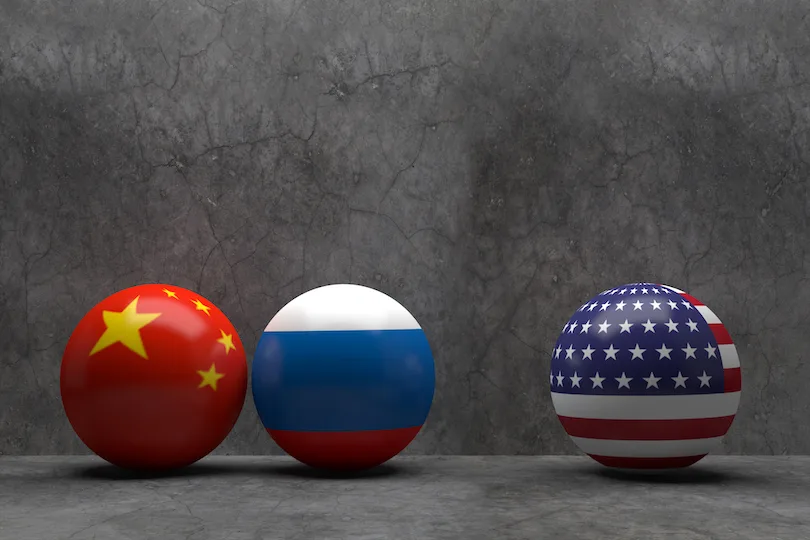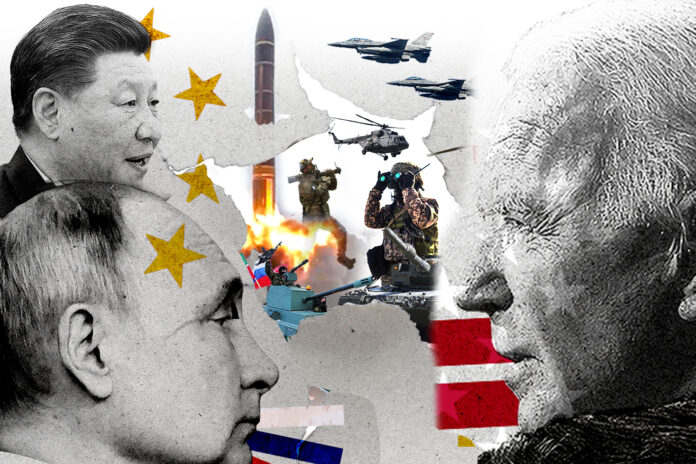
The new Cold War also known as Cold War 2.0 is characterized by simmering tensions, breach of international norms, proxy wars and arms race between the US on the one hand and major powers such as China and North Korea in the Indo-Pacific, Iran in West Asia and Russia in Eurasia on the other. For instance, Russia’s assertion of sovereignty over Ukraine and prolonged war with the latter since February 2022 pushed the US towards an armament race with Russia and the American administration kept supplying updated arms and ammunitions to the Ukrainian regime in a bid to contain Russia. In the post-Cold War era, neither the world emerged completely unipolar, nor did any world society become firmly established. On the contrary, a large grey area emerged where states moved from the pro-US foreign policy or clear anti-US or restricted foreign policy to a more independent foreign policy. While China is the key challenger to the US power and most important player in the new Cold War, many other regional powers challenge American predominance in different parts of the globe and maintain friendly relations with China. Primarily, the US began to face challenges from rising and revisionist China, assertive Russia and from recurring threat of Iran’s nuclear ambitions. While many experts define the American arms race and rising tensions with China as the new Cold War, others define it as the tensions and arms competition arising from the sharing objective of multiple regional players challenging the American hegemony.
Changing Dynamics
While the Cold War referred to power competition and arms race between two superpowers – the US and the USSR, the new Cold War involves multiple players such as China, Russia and Iran who seek to defy American hegemony and cooperate with one another to challenge the power position of the US.
Whereas the Cold War was a conflict for global ideological supremacy between American capitalism (promoting market economy) versus communism (promoting closed and state-controlled economy) of the Soviet Union, ideology plays a little role in the new Cold War as all the countries pursue market economy whereas communism/socialism in its conventional form is not practiced anywhere although there are socialist countries.
Some American experts see the new Cold War as a competition between two other ideologies such as American democracy versus authoritarianism of China, Russia and Iran. However, experts from other parts of the globe do not see this as an ideological competition as American foreign policy does not always promote democracy.
The competition for power and ideology between the superpowers spread across the globe. Proxy wars between allies of the superpowers also spread their tentacles across the globe. Intensity or dangerousness of conflicts was relatively low because of their global distribution and the American and Soviet attentions were divided although Korean crisis, Vietnamese war, Cuban Missile Crisis and Soviet intervention in Afghanistan received immediate attention of the superpowers. However, intensity of conflict between the competitors in the new Cold War is likely to be higher because of localized nature of conflicts. For instance, any conflict between the US and China will be confined to the Indo-Pacific region as China does not seek global hegemony like erstwhile USSR and hence Beijing is likely to bring in its entire power capabilities to the Indo-Pacific theatre in a war-like situation with the US.
Non-Alignment Movement (NAM) acted as a third bloc involving Afro-Asian countries who distanced themselves from the arms race and power competition of the Cold War and attempted to promote global peace by resolving Cold War related disputes and promoting disarmament. On the other side, NAM does not exist as a relevant actor during the new Cold War to resolve disputes and promote global peace.
While Cyber Warfare was not a feature of the Cold War as technology had not advanced to that level during those times, cases of cyber warfare are rising and it is a key feature of the new Cold War.
Much like the Cold War, contenders in the new Cold War avoid direct wars due to the possibilities of a nuclear catastrophe while militarization and proxy wars continue. Unlike the Cold War, the competitors also avoid direct war for another reason such as global economic integration. Any direct war in the era of globalization will cost them on the economic front too.
During the Cold War, the world was far from global economic integration and hence the allies took clear sides and fought against one another. Much like the proxy wars of the Cold War, the new Cold War involves proxy wars but with another dimension and more complexity such as shifting alliances between states on the one hand and secret and shifting alliances between states and terrorist groups on the other.
International laws and norms which came into existence in the post-World War scenario were soon violated by both superpowers. Doctrines of human rights and human security had not evolved then and states resorted to the doctrine of absolute sovereignty to violate international laws and norms. These laws and norms are violated by the competitors during the new Cold War despite their long years of evolution. As Israel has been witnessed violating these norms in its all-out war against Hamas. However, doctrines and laws related to human rights and human security still restrain certain militaristic actions of the contenders of the new Cold War. There has been palpable pressure on Israel from the international community to refrain from violating these laws. Looking back, both US and Russia had turned away from the INF treaty in 2019 to invigorate the arms race whereas there is no third block such as NAM to collectively work for peace and disarmament. With advanced weapons and weapons delivery systems available with the contenders of the new Cold War, the evolving great game is becoming bleaker despite the international laws and norms.
Unlike during the Cold War when the American camp and Soviet camp was neatly demarcated and the global economy was far from being integrated, the new Cold War witnessed the phenomenon of increasing use of American sanctions by the US as it plays a pivotal role in the global market economy and in a bid to check regional ambitions of competitors, it very often resorted to different types of sanctions.
India as a Party to the New Cold War
While India seems unwilling to participate in the evolving new Cold War, it is reluctantly becoming a participant and the Indo-Pacific region is fast emerging as the troubling global hotspot due to China’s significant economic and military rise and assertion of sovereignty in the region. India has made strategic moves to enhance its profile in the Indo-Pacific region by entering deep into the strategic ambit of the US and both signed Logistics Exchange Memorandum of Agreement (LEMOA) in 2016, the Communications Compatibility and Security Agreement (COMCASA) in 2018 and the Basic Exchange and Cooperation Agreement (BECA) in 2020 intended to provide India with real-time access to US geospatial intelligence. Both countries are co-developing air-launched unmanned aerial vehicles (UAVs) under the Defense Technology and Trade Initiative. While New Delhi has so far carefully crafted its Indo-Pacific policy and participation in QUAD so as to strengthen its maritime security and maintain a free and open region without explicitly endorsing a containment strategy aimed at China, Beijing’s continuous efforts to flex muscle and project of power in the Himalayan landscape as well as in the Indo-Pacific region could prompt India to take a categorical stance against China although it is already tacitly a party to the New Cold War and the evolving arms race.

